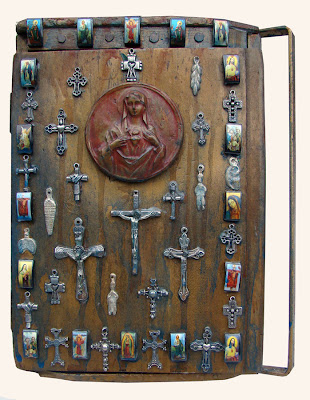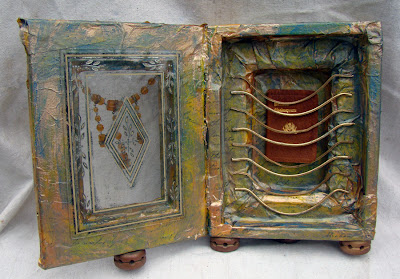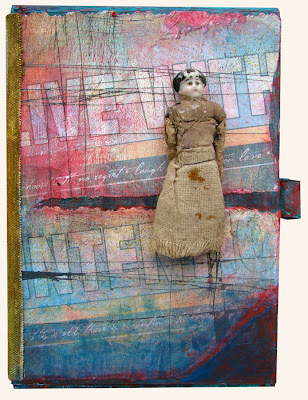SCROLL DOWN TO SEE THE NEW "PORTALS" BODY OF WORK! The Katrina Collection is a series of mixed media assemblages which incorporate storm debris from Hurricanes Katrina and Gustav. There are approximately 1000 pieces in the collection to date, so most of the pieces are in the archives, located on the right hand side of the poage-just scroll down a little bit.
Portal is the signature piece for this series. I began with a damaged plaster statue that somehow survived katrina. I paired it with a chain of Jesus and Mary beads from an oversized rosary, and part of a fireplace screen. it is nestled inside an ornate carved and painted box from the Far East, and enhanced with acrlic paint, milagros, and glass beads.
Animals Know Things is kind of a whimsical piece, but this piece also references the instinctual elements in our psyches, that part of us that does not have to be restrained by “reality” as we know it. I created this piece from an old piece of painted wood, a fragment of a decorative piece from a destroyed antique store on the beach, and a carved feline from that same store.
Window to the Past incorporates part of an old mantle clock with a shattered glass coaster, a miniature clay reproduction of an ancient Roman statue, three antique optician lenses, a shadowbox frame and photos I took in Istanbul, Turkey. Travel is a magnificent portal for me, and I am never more alive then when I am wandering among ancient civilizations.
Table Saint is a piece whose reference to portals is quite obvious; the idea of saints interceding for humans is a well-known Christian concept. I also think that this piece points to the notion of simplicity and direct contact in another way; many of my more powerful works are very simple in their construction. The saint was carved by artists in Guatemala, and the table top survived Katrina in Old Town Bay St Louis.
Squash Blossom Saint is a nostalgic piece for me; the Squash Blossom necklace at the saint's head was given to me many years ago by a lover. I kept it for a long time, until Katrina took it apart for me. Even then, I have held on to the fragments of that necklace. It was paired with an old metal shelf, a violin case, some pieces of wood molding, part of a fireplace screen and a gorgeous carved santo from Guatemala.
Sheperd signals its portal identity in two ways; first in the santo of Jesus and also in the doorway created by the two pillars. The pillars were actually pieces of some furniture that felt Katrina's wrathe, and the top and bottom pieces were from an old picture frame I salvaged from the beach. The support are cedar boards from a long-gone fence.
Saint of Firenze is one of my favorite Portals pieces. The cover features handmade paper, acrylic paint, canvas, the lid to an old powder case, and four metal spirals. The inside of the altar incorporates several more of the metal things, a metal fleur de lis napkin holder, more handmade paper and acrylic paint, and a praying saint made from polymer clay. "Firenze" is the name of the city in Italy that we call Florence, and the fleur de lis is their symbol. 5.5" x 8" x 2" closed
Sacrament began with an old wood box, the outside of which I affixed milagros, metal crosses, beads from a Saints bracelet, and a polymer medallion. On the inside, I collaged bits of found and handmade papers, fragments of photographs I took in Europe, an image of a Russian icon on a block of wood, more beads and an oval piece of glass. I have seen icons like this in the homes of some people, generally those whose religious beliefs played a big part in their lives. 11" x 8" x 4" closed
Rosebud Saint features the juxtaposition of a Guatemalan santo, a chalet-shaped shelf turned upside down, a kitchen cupboard door, two drawer pulls, a metal coaster and a polymer medallion of the Virgin Mary. I like to pair the rustic interpretations of the Virgin with the more polished, European depictions; it speaks to me of universal experience across time and space.
Reverence is a subtly complex piece that speaks to the power of the written word. I began constructing it by laying a picture frame inside of a hinged wood box, and covering the piece with a reproduction of an Abraham Lincoln document. I added other found papers, including a fragment of Arabic and an image of an ancient Greek stone tablet before staining the piece with several acrylic washed. A miniature book by Shakespeare with a leather cover was nestled into the niche, and chains were draped across the front of the niche. A piece of decorated glass was adhered to the inside of the cover and on the outside, I draped a broken necklace. Tinker Toy feet complete the piece. 10” x 8” x 4” closed
Power of O is another simple piece that combines the Santo, an old painted metal sign for a soft drink, a house number that serves as a halo and two cedar fence boards. There is something so powerful about these carved Santos that I often choose to keep their supports very basic. This piece also speaks to the wide variety of objects/images that can serve as religious symbols in different cultures on the planet.
Ottoman Empire is the piece in this collection which speaks most powerfully to travel as a portal in to other worlds. Forever drawn to cultures different than my own, I find travel in Muslim countries to be incredibly interesting, invigorating and rewarding. This box was first covered with photographs I took on my trips to Istanbul and the island of Cyprus. I added other bits of found papers, such as a page from a book in Arabic I picked up in the Grand Bazaar, before staining the papers with acrylic paint. I covered a wood manikin with cheesecloth and stained that as well, before soaking his turban in coffee to stain it. I positioned the figure in the box, and began adding embellishments. These include medallions from the Hagia Sofya, antique optician lenses, bits of old jewelry and a drawer plate, and some Arabic coins. The photos inside the box are of a mosque on the Bosphorus, and the old train station on the Asian side of that same river. The front cover combines a photograph of a walkway in Nicosia, Cyprus and a page from an Arabic book, and the back cover is a photograph of a building in the old walled city of Nicosia. 8" x 11" x 3" closed
Niche Saint starts with a terra cotta image of the Virgin of Guadalupe. I paired it with the door to a jewelry cabinet, a mosaic-style glass picture frame, a decorative trifold door, old coin, wood poker chips, and milagros. When I placed it in the battered wood box, it immediately made me feel as though I was in one of the old Spanish churches of the southwest.
Mask references my background in the field of religious studies. Somewhere in that massive load of books graduate students are required to read was a book about indigenous cultures in which masking is an important part of their religious experience. Donning a mask is much more than masquerading; by the act of masking, the devotee becomes what he/she is portraying. I find that a very compelling notion, and leads me to think about a tradition I have become very familiar with, that of Carnival celebrations. In Brazil, Venice and New Orleans (among other places) the donning of the mask allows a person to become someone else, if only for a short time. Obviously, masking is a powerful way to enter a portal.
Martin's Epiphany was a whole lot of fun to create. For those of you versed in the growth of the Protestantism movement in Europe, you know that the "95" on the inside cover references the Ninety-Five Theses, written byMartin Luther in 1517 and widely regarded as the primary catalyst for the Protestant Reformation. The disputation protests against clerical abuses of the Catholic Church and was nailed to the door of the Castle Church in Wittenberg, Germany. I began with a box that had already had the work of an old master on the cover, and altered it with washes of acrylic paint. On the inside of the box, I layered found papers such as a page from a German bible, as well as fragments of my photographs. Luther himself was created from a metal ceiling tile, an over sized reproduction of a penny n mismatched hands from a couple of dolls, a metal button and polymer clay. As you can see, Martin's heart is bursting with joy at his entry into a portal of new experience. 9" x 13" x 3" closed.
Live With Intention (or "Will Ye Go to the Indies My Mary?") is based around the miniature book of poetry by Robert Browning. I love these little books for their dual existence as book and as small treasure; they feel more like a precious jewel in your hands. This piece has several layers of references to transportation to another time and space. The poem I chose to feature references travel, in my opinion a fine method of portaling; the book itself references the remarkable ability of poetry and prose to take us around the world and beyond, and the found paper on the front cover indicates the necessity of self-awareness for meaningful experience. I covered the portal box in found papers, including an over sized page of the poem, and added the pieces of jewelry. On the front cover is, of course, Mary herself. 5.5 x 8" x 2".
Laughing Buddha II. Both of these Laughing Buddhas point to the Eastern familiarity with transportation to other realms. They also seem to give some advice about lightening up a bit; a laughing Buddha always makes me smile. I created these from some wood faces which may or may not have bee intended to be Buddhas, battered platters, and decorative wood and metal tiles.
Subscribe to:
Posts (Atom)
"Northeast Quadra nt" from The Katrina Collection The Katrina Collection is a series of mixed media assemblages which incorpor...

-
Copper Cross is composed from a rusty metal cross, a bent copper picture frame, a cabinet door and a charger. 15" x 16" SOLD
-
"Northeast Quadra nt" from The Katrina Collection The Katrina Collection is a series of mixed media assemblages which incorpor...
-
Endurance is a piece I made as a gift to my beautiful town, Bay St. Louis. Along with its sister city Waveland, Bay St. Louis was ground ze...


















































